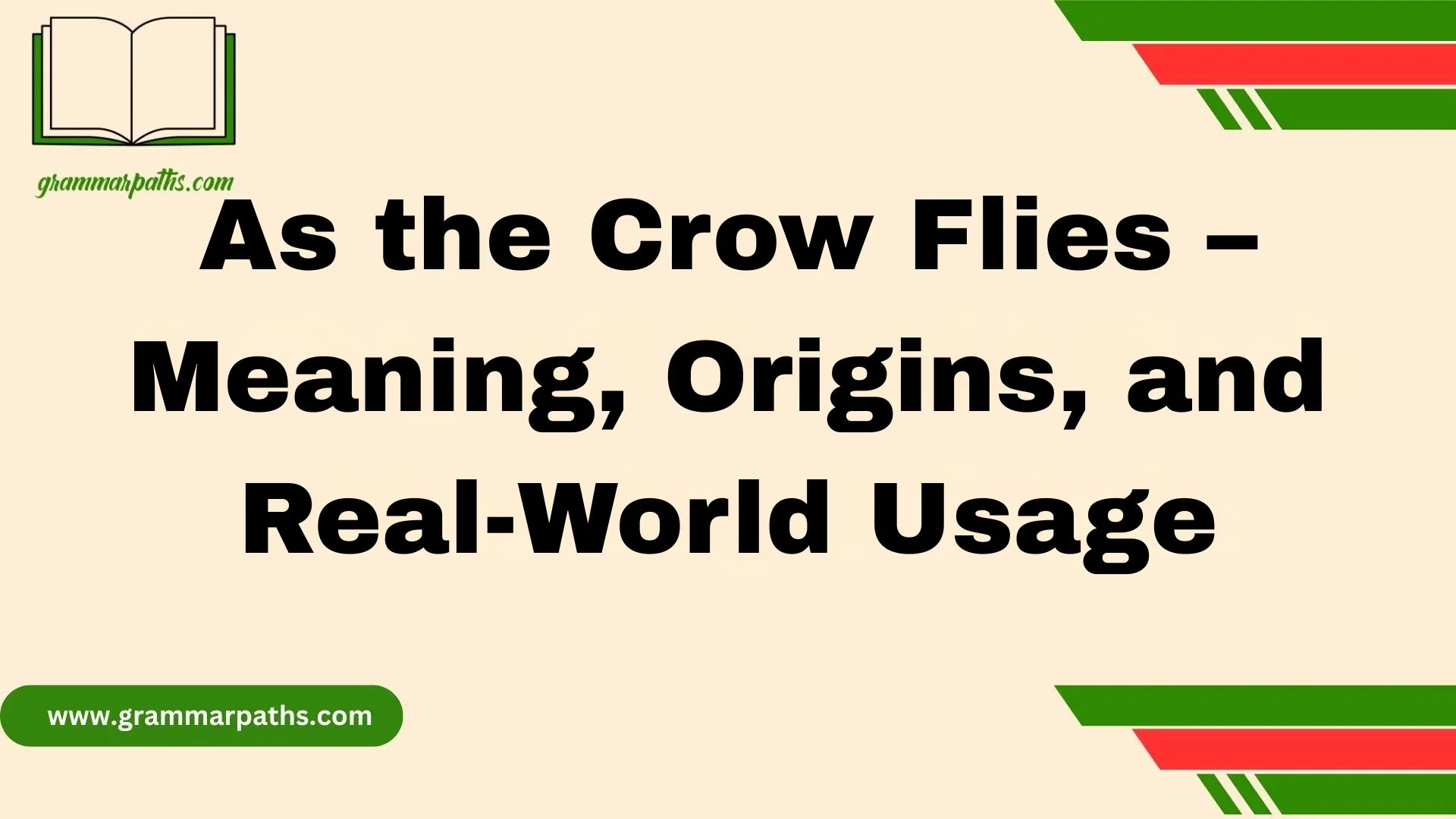I first heard the phrase “as the crow flies” when my uncle gave directions to his farm. He said, “It’s about 30 miles from here as the crow flies, but you’ll end up driving closer to fifteen more with all the turns and detours.” That stuck with me. It’s one of those idiomatic expressions that paints a picture so clearly—it shows the shortest, most direct line from one point to another, as if a bird, flying high and unswerving, could skip over roads, buildings, and mountains. The idiom doesn’t care about the winding path the rest of us have to take. It’s all about efficiency, simplicity, and cutting through the complex terrain of our everyday lives.
In conversation, we use it to express actual distances, especially when travel seems unnecessarily long. In America, it’s popular for describing how far things are without the constraints of existing roads. I’ve even heard people joke, “It’s ten miles as the crow flies, but fifteen as the Toyota Camry drives along Route 119.” It’s both quirky and clever, a fun way of discussing geography while highlighting the difference between usage and reality.
The concepts it carries—like understanding English skills, discussing ideas, or helping someone dig a bit deeper into language—make this phrase more than just a directional tool. It also emphasizes how distances are measured, how points connect, and how we often forget that flying directly is rarely an option on land. But if we could, the route would be measured in a straight, perfect line—no turns, no obstacles, no constraints. Just a crow, flying.
What Does “As the Crow Flies” Mean?
The phrase “as the crow flies” refers to the shortest distance between two points in a straight line, ignoring roads, mountains, rivers, or any other obstacles.
In Simple Terms:
It’s the direct line from point A to point B, like drawing a straight line with a ruler on a map.
Real Example:
Let’s say you’re in Chicago and your friend is in Milwaukee.
- Driving distance: about 92 miles
- As the crow flies: only about 83 miles
That 9-mile difference? That’s winding highways and city traffic for you.
Quick Chart:
| Route | Distance (Miles) |
| New York to Boston (road) | 215 |
| New York to Boston (crow) | 190 |
| Denver to Salt Lake City | 520 |
| Denver to Salt Lake City 🐦 | 370 |
Where Did the Idiom Come From?
Maritime Origins
The idiom is thought to have roots in 18th-century British navigation. Sailors at sea needed ways to find direction before modern instruments. They believed that if a crow was released, it would fly straight toward land—hence, the “shortest route.”
Ships even had something called a crow’s nest — the lookout point high on a mast. Some believe the name came from keeping caged birds up there to help navigate.
First Recorded Use
The phrase appeared in print around 1800, with earlier maritime references possibly existing even before then.
“It is said to be ten miles as the crow flies…”
— An early 19th-century British newspaper
Do Crows Actually Fly in Straight Lines?
Surprisingly, not always.
Crows are intelligent birds, but like most creatures, they don’t always travel in perfect straight lines. They fly efficiently, but they may veer for food, obstacles, or wind patterns.
So while the idiom sounds like it’s based on bird behavior, it’s more about imagined directness than scientific accuracy.
How It’s Used in Everyday American English
In the U.S., people use “as the crow flies” casually to describe distance, especially when comparing it to a longer travel route.
Examples:
- “The town’s only 10 miles away as the crow flies, but the highway takes you 18.”
- “He lives about 30 miles from me, straight-line, not by road.”
It’s common in:
- Real estate: “The lake is 2 miles away—as the crow flies.”
- Hiking: Estimating trail vs. straight-line distances
- Weather reports: Storms tracking between cities
As the Crow Flies vs. Actual Distance
Here’s why this idiom matters: straight-line distance isn’t always helpful.
Consider:
- Mountains
- Rivers
- Restricted zones
- Highways and detours
So even if a place is close “as the crow flies,” getting there could take much longer.
Table: Real US Examples
| City Pair | Crow Distance | Road Distance |
| San Francisco → Oakland | 8 miles | 12 miles |
| Miami → Fort Lauderdale | 25 miles | 32 miles |
| Nashville → Memphis | 196 miles | 210 miles |
| Dallas → Houston | 225 miles | 240 miles |
The Geodesic Reality
The Earth isn’t flat, and neither is the shortest path across it.
Geodesic distance refers to the shortest route over the Earth’s surface — a curve, not a straight line on flat paper.
Airlines and satellites calculate routes this way. So even “as the crow flies” isn’t always perfectly straight in three-dimensional space.
Modern Use in Tech and Navigation
Despite being old, the idiom has found new life in technology.
Where It Shows Up Today:
- GPS and Mapping Tools: Many apps offer straight-line estimates
- Drones: Direct aerial paths between points
- Geographic Information Systems (GIS): Used for urban planning and logistics
- Search and Rescue: Estimating range or travel time in emergency zones
Apps like Google Earth, OnX Hunt, and Garmin Basecamp allow users to measure straight-line distances between waypoints.
Synonyms and Related Idioms
Sometimes, people use alternative phrases to say the same thing:
Common Variations:
- “In a straight line”
- “Bee-line” (another idiom meaning direct route)
- “Point-to-point”
Other Idioms for Distance or Direction:
| Idiom | Meaning |
| “A hop, skip, and a jump” | Very short distance |
| “Throw a stone’s distance” | Close enough to throw a rock |
| “Out in the boonies” | Far away or remote area |
Common Misconceptions
Many assume “as the crow flies” means “easy to get to.” But that’s not always true.
Key Differences:
- Straight doesn’t mean simple
- It ignores real-world challenges like terrain, property lines, traffic
- You can’t always go directly from A to B — especially not on foot or by car
Example: You may live 5 miles from a beach “as the crow flies,” but need 12 miles of roads to get there because of rivers or fences.
Pop Culture & References
The idiom pops up in movies, music, and books—usually to describe distance or hint at a deeper metaphor.
Some Appearances:
- Johnny Cash, As the Crow Flies – a song about love and distance
- TV Shows: Often used in crime dramas or survival series
- Books: Title of novels and short stories dealing with travel or isolation
When to Use (And Avoid) the Idiom
Use It When:
- Estimating or comparing direct distances
- Speaking informally or metaphorically
- Describing aerial or satellite paths
Avoid It When:
- Giving legal or technical instructions
- Planning precise travel times
- Writing formal documents or contracts
Quick Table: When to Use
| Situation | Use the Idiom? |
| Chatting with friends | ✅ |
| Writing real estate copy | ✅ |
| Navigating city streets | ❌ |
| Legal description of property | ❌ |
Conclusion
The phrase “as the crow flies” is more than just a clever way to describe distance. It reflects how we wish life could be—straightforward, direct, and without the detours, turns, or obstacles we often face. Whether you’re describing a farm that’s 30 miles away in a straight line, or you’re joking about the extra miles your Toyota Camry has to take along Route 119, this idiom speaks to the difference between ideal paths and real-world travel.
Understanding this English phrase adds depth to your language skills, helping you navigate not just roads and terrain, but also conversations, concepts, and life’s complex journeys. So next time you hear someone say “it’s ten miles as the crow flies,” you’ll know they’re talking about the shortest, most efficient route between two points—even if reality demands a much more winding path.
FAQs
What does “as the crow flies” mean?
It means the shortest distance between two points in a straight line, without considering roads, turns, or obstacles. It’s how a crow, or any bird, would fly over land or terrain without following man made paths.
Is “as the crow flies” still used today?
Yes! It’s a popular idiom in everyday conversation, especially in America, when talking about distances. People use it to contrast real travel routes with the direct line distance.
Is it only used for real geography or travel?
Not at all. While it’s often used when discussing actual miles or routes, it can also be used figuratively—to express the idea of getting from one point to another in the most efficient or simple way possible.
Why do we say “as the crow flies” and not another bird?
Crows fly in a straight, unswerving line and don’t follow roads. They were believed to take the shortest, most direct route. That’s why they became the perfect example for this idiom.
How much can “as the crow flies” differ from real road distance?
Sometimes, quite a bit! For example, a distance that’s 30 miles “as the crow flies” may be forty-five miles by road if there are mountains, buildings, or bends in the path.

Grace Marie is the dedicated writer behind GrammarPaths.com, where she shares her passion for English grammar, idioms, and writing mastery. With a strong background in language studies and years of experience helping learners improve their communication skills, Grace creates clear, practical, and engaging content that makes English easy to understand.












